Delidding The AMD Ryzen 5 2400G APU: How To Guide and Results
by Gavin Bonshor on May 10, 2018 8:00 AM EST- Posted in
- CPUs
- Guides
- APUs
- Ryzen
- Ryzen 3 2200G
- Ryzen 5 2400G
- Delidding
- Delid
Delidding The Ryzen 5 2400G Results and Conclusion
There has been a lot of hype since the launch of the Ryzen 2000 series APUs and in our Ryzen 5 2400G review, it’s noted that in multiple scenarios they outperform the competing Intel counterparts second to none in pixel rendering tests such as gaming, mainly thanks in no small part to the integrated iGPU featuring Vega cores. The aim of today’s testing with our best Ryzen 2000 series APU from a purely CPU frequency-based standpoint was to ascertain whether delidding makes a noticeable improvement to thermal performance, as well as determining if any extra headroom in CPU core frequency is made available.
As per our regular motherboard testing methodology when we find the max stable overclock, testing was done following the same procedure. Following on from the testing done in our Ryzen 2000 series APU overclocking guide, the aim in this was to continue with simple overclocking to push the core frequency.
To start, here are our initial overclocking results with the retail chip as sold:
After delidding the chip, replacing the paste with a liquid metal TIM, we achieved the following results:
Not only are the thermal properties improved from delidding and having the IHS slavered up with Thermal Grizzly Conductonaut liquid metal compound but operating at the previously unstable frequency of 4.2 GHz was made possible after delidding. Even at 4.2 GHz with the 2400G delidded, the temperatures hit the same levels as 4.0 GHz non delidded which is quite impressive. Even more monumental was the system managed to boot into Windows 10 at a clock speed of 4.3 GHz, although the system wouldn’t just hang when OCCT was fired up, it would crash completely meaning that even with a good AIO CPU cooler and being de-lidded, no more than 4.2 GHz was stable with this particular chip.
The best way to represent some of this data is in graphs. First up is the main one, temperature:
This is a clear representation showing the decrease in CPU temperature after the delidding process. The higher the frequency, the bigger the overall difference!
For power consumption, there was almost zero difference. This is to be expected: the chip will still consume the same amount of power with a standard temperature window. The cooler still has to remove the heat energy, however it is now being transferred better to the cooler through the new TIM.
The interesting result here is POV-Ray. We use POV-Ray in our overclock testing as it is usually very good if there are cache and memory errors associated with the high frequency. However here we see that beyond about 3.8 GHz, the retail processor has trouble getting more performance at a higher frequency, likely due to the CPU reaching thermal limits and the frequency mechanisms having to compensate. The end result is 'sustained' performance at higher frequencies. Due to the delid process, this was not an issue through to 4.2 GHz. Having the extra thermal headroom ultimately gave both more frequency and better sustained performance.
Is Delidding the Ryzen 2400G Worth it? Risk Versus Reward
As previously stated, the primary use where I could see delidding a Ryzen 2000 series APU viably applicable would be in a situation where cooling restrictions are in place such as a small form factor system or a HTPC. The benefits of the reduction in temperature would allow for a more svelte and slim line cooler to be used without pushing towards the maximum operating temperature.
Another less but pertinent use would be for performance users wanting faster clock speeds, although at a cost of voiding the warranty, potentially damaging and killing the chip itself during the process, and the added cost of the tools, it could be a price too much in retrospective which could be spent on a better CPU to begin with. Some vendors in the EU such as Caseking are actually selling pre-delidded Ryzen 3 2200G and Ryzen 5 2400G chips with their own warranties at an additional cost, which is often a better idea than manually performing the process and shelling out for the extra tools. That’s all good, providing this option is available to the user, although so far, I have yet to be able to find a large vendor offering this service in the US.


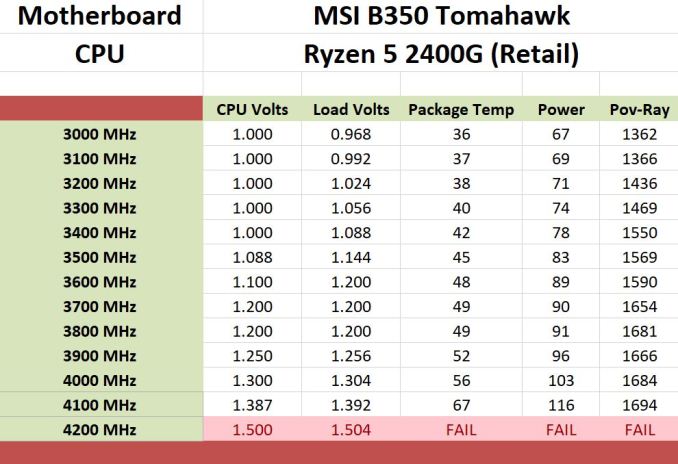
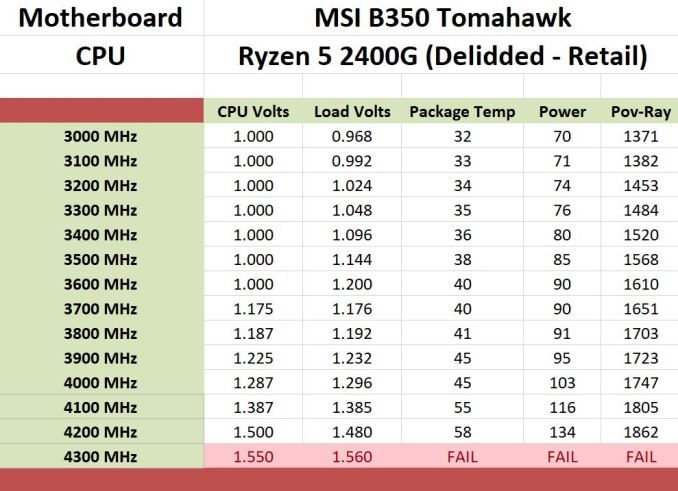
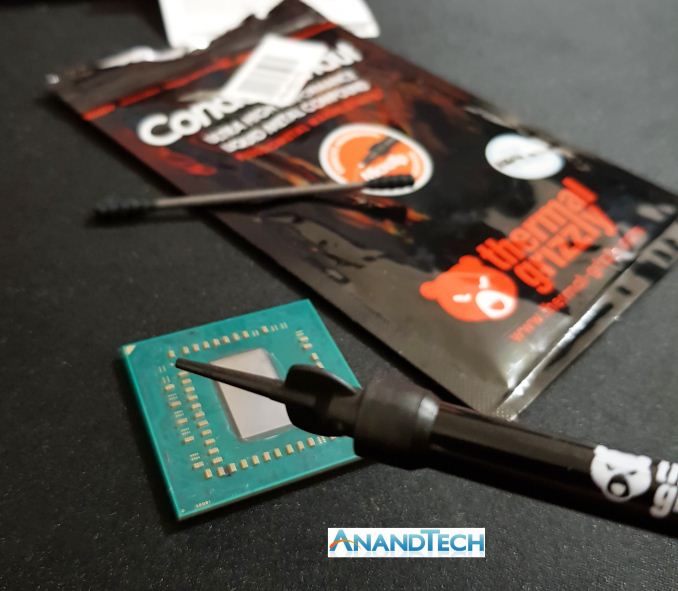
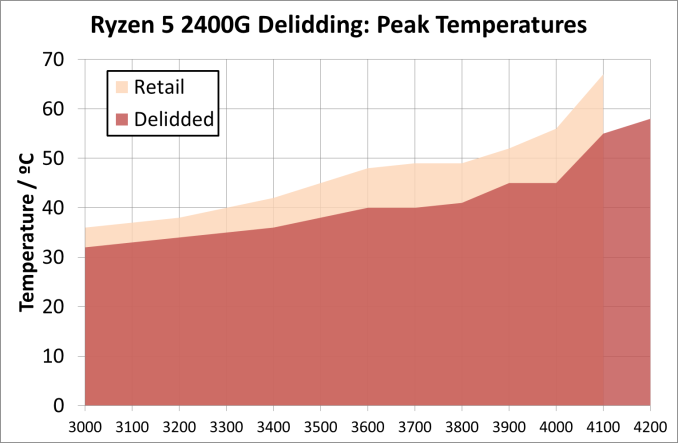

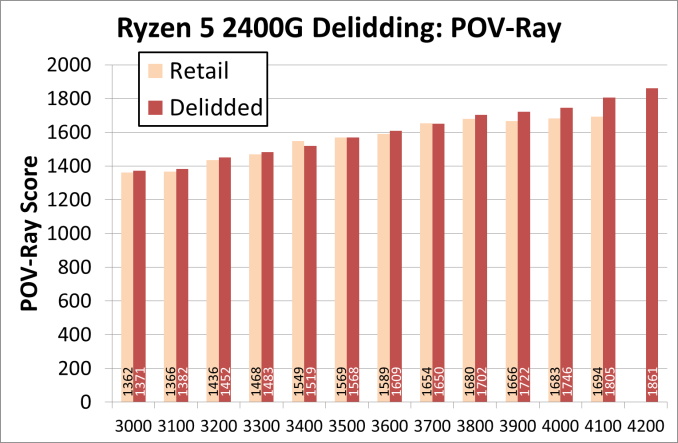








73 Comments
View All Comments
JoeyJoJo123 - Thursday, May 10, 2018 - link
>OUT>OF
>BOX
>THERMALS
DanNeely - Thursday, May 10, 2018 - link
A recent article on delidding Intel CPUs on [H]ardOCP suggested using clear nail polish to paint over SMD components to protect them against stray TIM.gavbon - Thursday, May 10, 2018 - link
Yeah that does work, it's the exact same method as der8auer uses, but I wouldn't want to test the theory out of purposely trying to short SMDs with liquid metal; that's the main issue other than damaging the die.kupfernigk - Saturday, May 19, 2018 - link
Given the cost of the CPU it's probably better to buy actual potting compound from somewhere like Element 14. This will also provide moisture protection.bill.rookard - Thursday, May 10, 2018 - link
What I would like to see is a kit to delid, get some indium solder, some spring loaded clamps, and a very precise baking temp... Solder that sucker on.gavbon - Thursday, May 10, 2018 - link
Would be interesting to say the least!edzieba - Thursday, May 10, 2018 - link
Probably a very bad idea: http://overclocking.guide/the-truth-about-cpu-sold...rocky12345 - Thursday, May 10, 2018 - link
Interesting read for sure from the link you provided. I am not sure if it is good or bad but all I know is my Sandy Bridge 2600K@5.1Ghz (soldered) has been running at this speed and has had the same temps since day one of me getting it way back then. I am not sure if there are micro cracks in the solder or not but it performs the same today as it did in 2012. Then again my temps 98% of the time are always at or around 45-63c under full load and idle temps 21-23crocky12345 - Thursday, May 10, 2018 - link
I wanted to add that I also do not spend very time doing stress tests that bake the CPU to the point of cooking itself. I spend most of my time just messing about in Windows and Gaming which is far easier on the whole system than running stress tests 24/7 like some people tend to do.DanNeely - Thursday, May 10, 2018 - link
That was liquid N2 testing that he was cracking them so fast under, air/water cooled will have much smaller thermal gradients and thus much slower rates of crack formation.